TMW #114 | The contextual renaissance
Welcome to The Martech Weekly, where every week I review some of the most interesting ideas, research, and latest news. I look to where the industry is going and what you should be paying attention to.
👋 Get TMW every Sunday
TMW is the fastest and easiest way to stay ahead of the Martech industry. Sign up to get the full version delivered every Sunday for this and every TMW, along with an invite to the TMW community. Learn more here.
The School of Athens is one of the world’s most famous works of art. Created by Italian Renaissance artist Raphael over three years during 1509 and 1511, it’s also one of my favorites.
The painting symbolized a radical shift in European intellectual life, one that rediscovered the ancient philosophical works of Plato and Aristotle, inspiring new inventions in engineering, academia, and art which led to modern science and the university.
In the case of whatever happens after third-party cookies, contextual advertising is having its own renaissance moment — a rediscovery of the old to inspire the new.
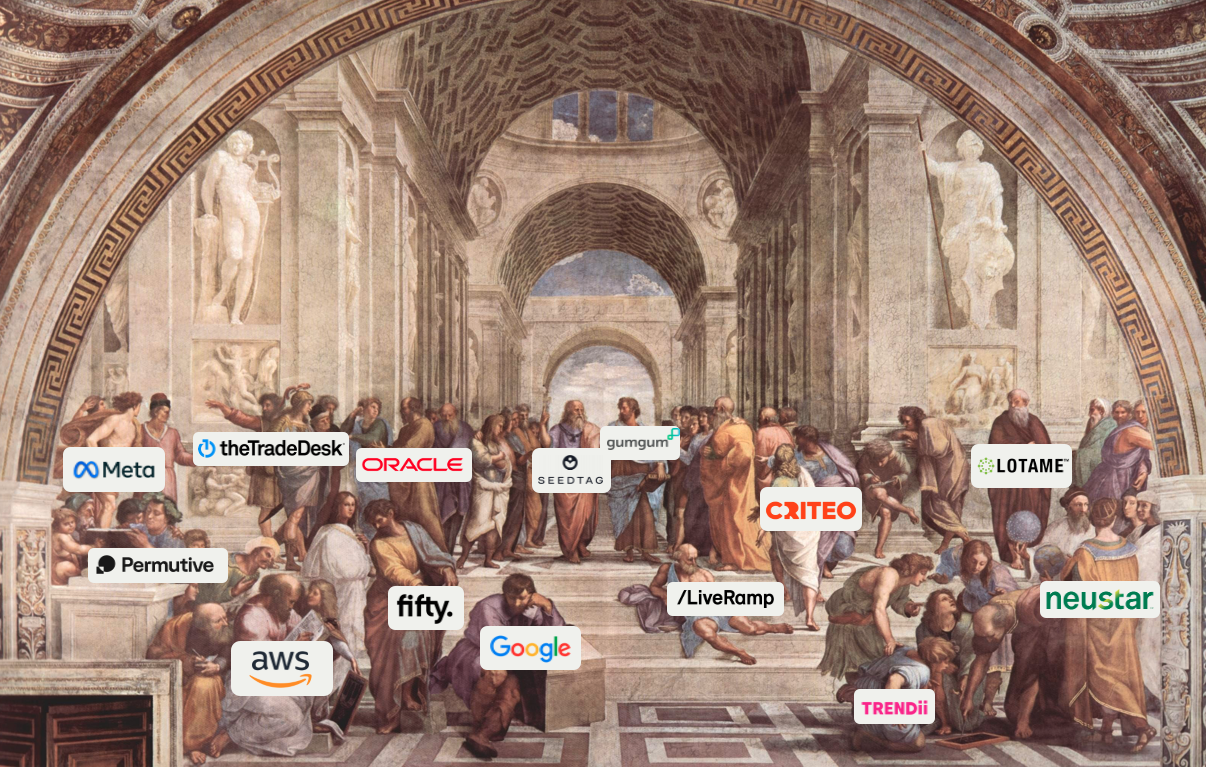
An often-neglected format of advertising that doesn’t get the same kind of interest as other areas of the AdTech space, the contextual side of the advertising coin is having its own renaissance in the face of third-party cookie deprecation, as marketers and advertisers look for alternatives.
A couple of essays back, I broke down the three main streams of thought driving what happens to digital marketing after devices and browsers no longer support the third-party cookie. “The day customers stop sharing data”, which is the idea that we should just move down the chain to first-party data as a suitable replacement for third-party cookies, introduces a whole new world of risks and challenges with preserving privacy.
But maybe there’s a better way that has been sitting under our noses this whole time?
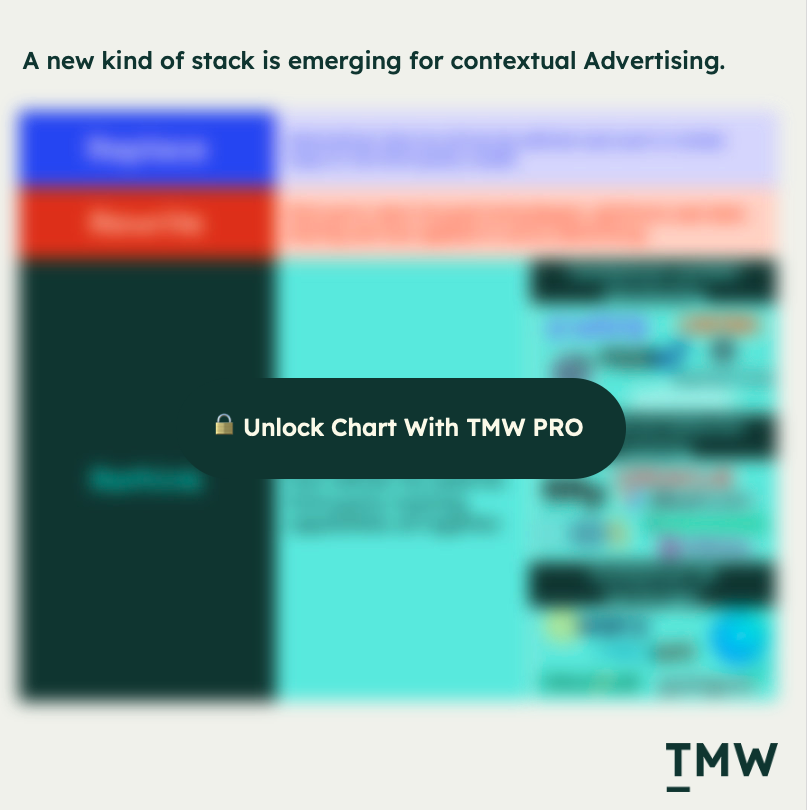
The old-made-new technology category that is contextual advertising asks a completely different question to what comes after the third-party cookie. Should we ditch the idea that collecting and sharing data on people makes for more effective marketing?
The answer from the growing movement of technology companies, publishers and marketers is that yes, we should ditch it. According to GIA, the contextual advertising market is forecasted to reach $562 billion by 2030, with an optimistic forecast of 180% growth ($362 billion) from 2022 to 2030, which is about 6% of the total programmatic advertising market by 2031. Small, but nothing to sniff at.
What’s interesting about contextual advertising is that it’s a category in the technology industry that’s as old as online advertising itself, and has only seen a very small portion of the overall internet economy for advertising. Most of the interest in what you can do with contextual peaked way back in 2004, and is only starting to rise again. There is nothing new under the sun.
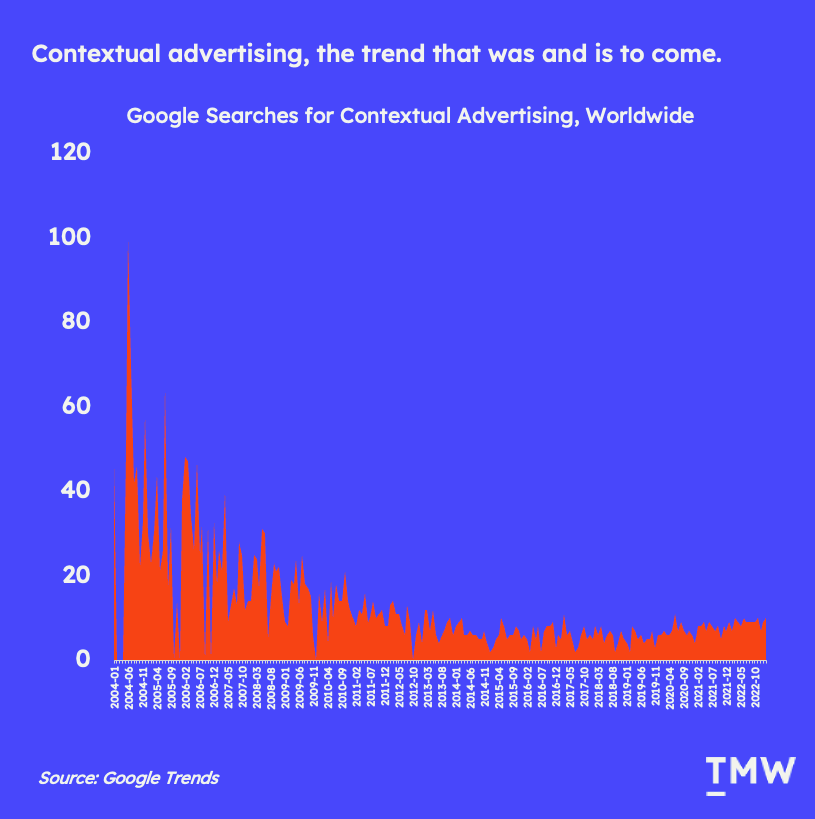
How much do you need to know?
The internet has limits on what you can know about someone – after all, you can only really infer things about people through their device use and the data they choose to share. But even with this limitation, you can still get close to a fully-formed picture of a person’s desires, needs, problems, and interests.
The third-party cookie leveraged this across a sprawling ecosystem of ad networks collecting and sharing some of the most personal data ever. In a way, third-party cookies enabled one of the largest behavioral data collection projects known to humanity.
According to the ICCL, Real-Time Bidding (RTB) – the primary mechanism for targeting users with programmatic advertising – is processing and passing personal data more than 294 billion times a day. The machinations of collecting, aggregating, segmenting, sharing and monetizing your online life are now at a scale that no human can comprehend.
If we extrapolate the daily figure here we get into silly numbers: 107,016,000,000,000 instances of data sharing a year. It’s too big even to comprehend, but it represents the perceived and actual value of targeted advertising by using personal data collected on our devices, attached to our identities, and used to infer our behaviors.
All of these efforts were funneled towards a singular goal: How can marketers show you a more relevant ad? That’s it. In 2022 alone, spending on digital advertising reached $586 billion, with some of the most innovative minds in technology and countless hours spent on reaching this singular goal. But maybe we’re ready for a different solution? Contextual could be it.
There’s a misconception that this amount of spending on internet advertising is why we have free products and services. But it’s not good enough to say that behaviorally targeted advertising is that reason.
It’s true that this format of advertising was the engine behind some of the world’s largest companies (Meta and Google), and why a whole host of unicorn AdTech platforms like Lotame, The Trade Desk, DoubleClick and LiveRamp exist.
Twenty years ago, these technology companies were revolutionary for precise, personalized and relevant ads. But the situation has changed drastically since then. In a way, the second-order effect of behaviorally-targeted advertising was that it created monopolies. As we’ve seen with search and social media, whoever can do the most with the data can own the entire ecosystem.
Newspapers, television, and out-of-home were all spectacularly large advertising businesses before the internet came along, and they are still large after 20 years of disruption. And while they relied on circulation numbers, television ratings, and population clickers to measure things like reach and effectiveness, there’s a good reason they are still important to marketers: they offer very different, and often more compelling creative formats.
In many ways, advertising was flying blind for a hundred years before we could track a click, video, watch, and scroll and tie that back to revenue. We’re relatively still early on that journey, and if we’re still early, there are plenty of opportunities to explore other ways to grow brands online. If anything, making the third-party cookie go away is a strong signal that the industry is ready for something new.
Customer data has an expiry date. And the challenge with third-party cookies, while admittedly effective, is that it’s very hard to know which data points in a user’s history are still relevant at all. Depending on the category, you could be in the market for a product for 3 months, 3 years or 30 seconds.
This is yet another reason as to why it’s important to put the right context around the data we collect, and think more deeply about the value of both knowing and not knowing things about our customers. And that’s the challenge of contextual – you don’t need to know a lot about people to drive effective campaigns and ads.
Context in context
Contextual advertising works across three data points: the behavioral data collected from a user during a session; the metadata of a product listing, article or media asset; and the past effectiveness of an ad set. It’s a three-way supply chain that connects brands with publishers while limiting the amount of data used for targeting by inferring what a person is interested in based on their immediate experience on a website.
And this supply chain is growing, with a wide variety of Martech companies building solutions from the exchange to the end-user experience. The category is expanding and leveraging all kinds of machine-learning tools and methodologies to make contextual effective.
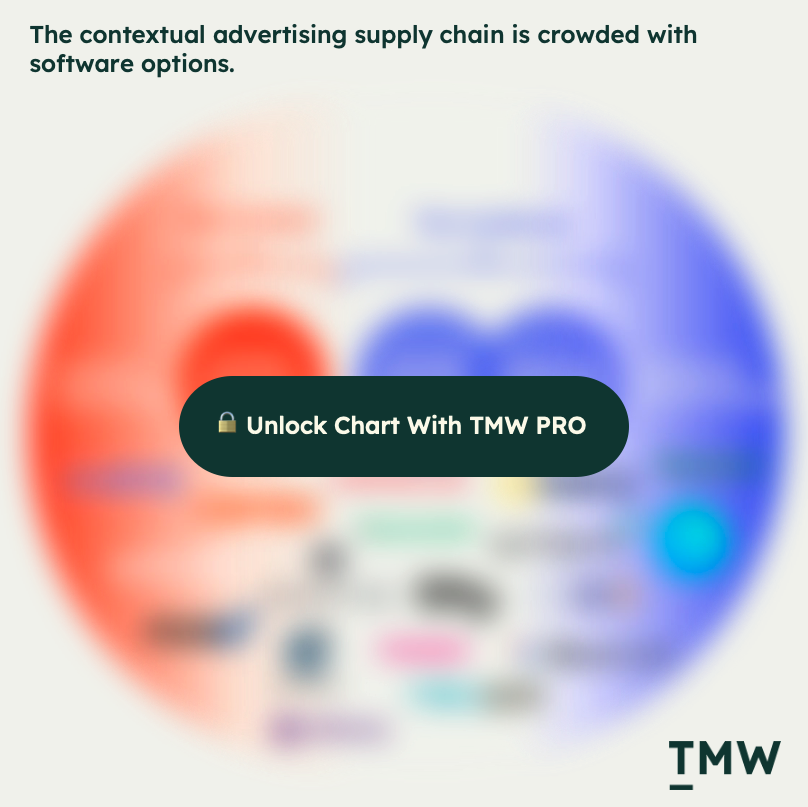
The way contextual is different is in the way the data is not shared with anyone outside of the immediate publisher’s own four walls. For many publishers, user data is isolated to a single session (so as to not build up a long tail profile of a user’s interests), and by using AI and an algorithmic approach to advertising, an ad slot is determined by the matching of the topic or product categories of a web page (the context) with what else a user has browsed to determine the optimal ad to place in front of that user (the audience).
None of these data points require data to be shared between a brand and a publisher. None of these data points require granular tracking or the identification of users. Contextual flies in the face of the main ways we’ve come to understand how advertising works on the web.
That’s why contextual advertising can be great for some strategies. Because data is not shared with outside brands and platforms, it limits a brand's measurement capabilities, and so that’s why many in the industry are suggesting that it's great for top-of-funnel type activities, where reach and awareness are very important.
In a way, this helps to solve the problem of the limitations of first-party data-driven advertising that is usually not as plentiful nor scalable for situations where you need to reach a lot more people.
Civic Science suggests that over time, ad relevance is growing, and this is due in part to the ability of contextual advertising to become more optimized in how it understands the content someone is browsing, while also making a decision on that behavior to show an ad.
That’s the reason contextual advertising is such an appealing option in a post-privacy internet. It still allows for a data-driven approach to advertising that’s arguably smarter than ever given the sophistication in analytics and machine learning in publishers, but it also respects their privacy and their data. It balances the trade-off remarkably well. If contextual advertising solutions can scale up both awareness and effectiveness, then we have a strong contender for a far more optimal way forward out of our third-party cookie malaise.
Despite this rationale, the technology category is still relatively under-adopted compared to most other ways of doing online advertising. According to a 2021 Winterberry outlook report, search, first-party custom audiences, and RTB still crowd out contextual advertising as a solution for selection by marketers.
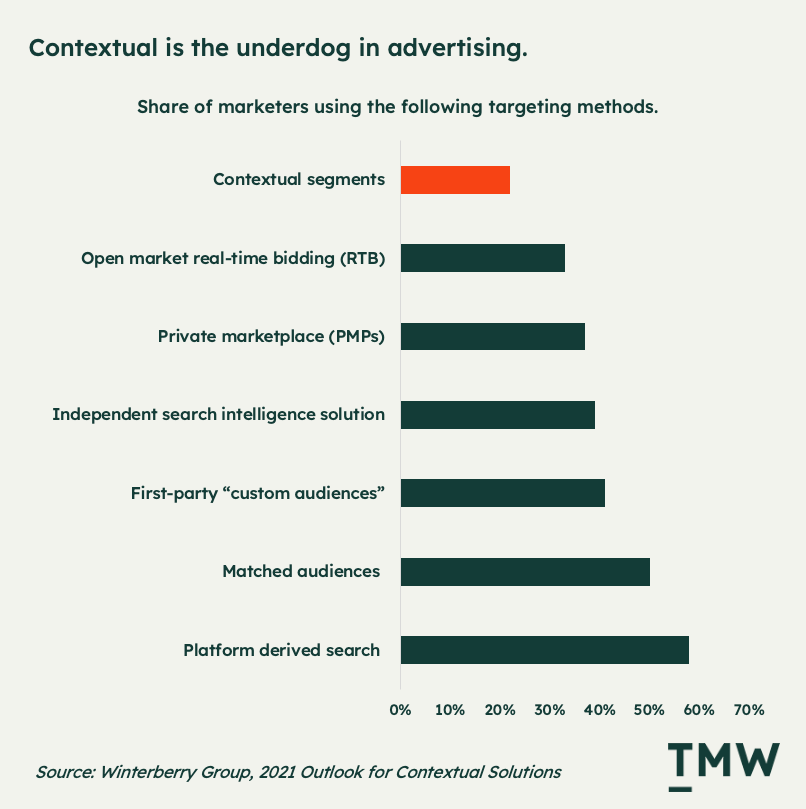
But that is changing. A few studies suggest that because it fits into the immediate context (instead of inferring interests that build up over time), it leads to better advertising, as users are not perturbed by what’s driving the selection of an ad in their session. Sure, the experience of advertising on a platform or publisher will always be an ever-present challenge to manage, but overall, there’s a lot of value here to unlock.
Dumb tools for a dumb internet
Third-party cookies were a dumb tool for a dumb internet. The internet technologies of the early 2000s all coalesced around a handful of companies with the right amount of scientific and engineering knowledge. But 20 years later, the situation has changed. Now engineering, data, and computer science talent are inundating the local e-commerce company, the news publisher, or are on the frontiers of building new Martech.
This reminds me of the ill-fated Helivector. An invention in the early days of aeronautics that looked cool until someone fell off it and it turned into a giant meat grinder.

The heli-vector was an interesting idea, in that it was a precursor to a personal flying car. But it was a not-quite-right innovation that suited some parts of solving mobility but was ultimately too dangerous.
The third-party cookie has an element of danger in it too. It’s not so obvious, but the construction of elaborate tracking operations can lead to real consumer harm. BlueKai, the data management platform that boasted the largest marketplace of user identities, has been hacked several times along with a great number of other AdTech platforms.
This has invisible harm to users who have their identities stolen or their privacy violated, but it’s harm all the same. The third-party cookie is like the heli-vector – it’s a solution too dangerous to continue with.
Clearly, the way internet advertising works today is struggling along under its own weight – an old technology in a period when the internet was dumber. That’s why I’m excited about contextual advertising as it does several things that third-party cookies couldn’t do: it creates incentives for data analytics maturity from a wider variety of companies that run contextual ads; it helps to keep content and services free for users; it gets outcomes for publishers; and it goes much further in ensuring that people’s privacy is indeed kept private.
While saying this, contextual still needs work for it to become a breakthrough option in a crowded post-cookie landscape. But as AI and the ongoing advancements in analytics and decisioning have come a long way, there are even more opportunities to take contextual advertising further.
Platforms like Seedtag, which recently raised €250m, are differentiating by leveraging AI, computer vision and language-learning algorithms to analyze web content and product listings in a way we’ve never been able to do before. For contextual to break through, a deeper form of intelligence is needed beyond the tags on a product or article – it needs to understand the nuance of content and imagery.
Other companies like Trendii go deeper into product catalogs to tag and identify content matches on publisher websites, creating its own data ecosystem from which you can match ads to content, while GumGum attempts to own the entire supply chain from ad exchange through to contextual ad placements and analytics.
Smart tools for a smart internet
While there are a handful of companies innovating in contextual, we can go beyond what is working today. Consider the advent of large language models that can not only infer what a person is reading through content metadata but can also read and categorize content in real-time to personalize an ad to them, in their specific context, that is tied to whatever they are reading at that very moment.
AI can do better analysis faster and in a more nuanced way. So much so that reliance on any kind of historical data collection from users in advertising could become obsolete. Why go to all the effort of setting up elaborate data-sharing technologies for first-party data and finding ways to keep consent in check with users to protect privacy when their data will nonetheless be shared around the sprawling network of advertisers?
There’s a wave of obsolescence coming to the advertising side of technology that will be impossible to stop when AI can infer our interests better, faster and cheaper than some ramshackle and disjointed schema of past behavioral data that was likely contaminated, out-of-date and verging onto damaging society.
With AI breaking new ground in 2023, there’s plenty of room to optimize the decision for an ad (who gets what) but also the experience (dynamic content within ads that are specifically relevant to that context). And despite the category’s long internet lineage, there’s potential for a fresh wave of innovation in no-cookie marketing.
Old money, new town
In reality, what did third-party cookies solve outside of the domain of advertising? Besides some learnings about large-scale behavioral analytics, we’re not any better off that the technology existed.
My working hypothesis is that contextual advertising could play an enormous role in realigning the entire economic situation of the internet. Advertisers will still spend, publishers will still publish, and people are still going to get ads.
Contextual advertising gives us a solid rationale against the notion that tracking people = better ads. And with the advent of better AI solutions that are constantly optimizing, there’s a good chance we won’t need tracking at all in the way we know it today.
Contextual advertising is the primitive of a cookie-less internet for advertising. It’s the foundation from which many other smart tools and products can be built up from to maintain the balance between the accessibility and monetization challenge of an open internet.
Besides, the future of advertising is currently at a crossroads. On path one, we go deeper into tracking and behavioral targeting with more sensitive first-party data, or we can go with path two - we find new ideas that can solve the same problem of ad relevance without having to know our behaviors and web history. The winds of privacy are blowing over the industry, and if the marketing technology industry is smart enough, hopefully, we will pursue path two.
Instead of thinking about cookies as a backup plan for when even more privacy regulation eventually hits, we have a real opportunity to evolve internet economics and make better deals between publishers, brands, and audiences. The contextual renaissance is upon us, it is time for new inventions.
Stay Curious,
Make sense of marketing technology.
Sign up now to get TMW delivered to your inbox every Sunday evening plus an invite to the slack community.
Want to share something interesting or be featured in The Martech Weekly? Drop me a line at juan@themartechweekly.com.
